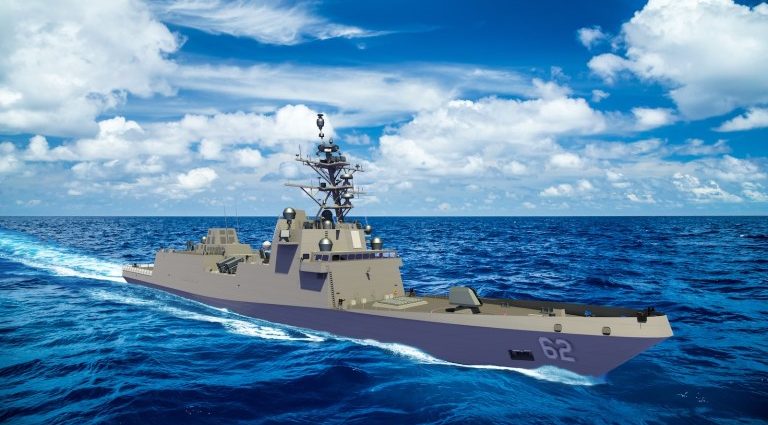China is building its next-generation frigate with a design indicative of increased global deployments and features to match the latest US naval combatants.
Last month, Naval News reported that China is now likely building its long-awaited Type 054B frigate, the successor to its Type 054A, of which 40 hulls have already been made. The report shows satellite photos of the Hudong shipyard where a warship is in an early stage of construction, with some modules in place.
The report mentions that the new ship might be the Type 054B or a new class called the Type 057. Furthermore, it states that the partially completed ship is bigger than the Type 054A, with dimensions closer to the Type 052D destroyer that has an estimated length of 147 meters, a beam of 18 meters, and an estimated displacement of 6,500 tons.
However, due to the early stage of construction, no definite conclusions can be drawn yet about the ship’s loadout. But China’s next-generation general-purpose naval combatant will likely align with plans to increase its expeditionary warfare and power projection capabilities.
The PLA-N is the world’s largest navy in terms of hull numbers. According to the US Department of Defense (DOD) China Military Power Report, the PLA-N consists of approximately 340 ships and submarines, with around 125 major combatants.
The report also estimates that the PLA-N’s battle force is expected to grow to 400 ships by 2025 and 440 ships by 2030, with much of this growth to come from major combatants.

In contrast, the Center for Strategic and International Studies (CSIS) notes that in 2022 the US Navy fleet size was 296 ships, with the former Trump administration’s 355-ship plan deemed unfeasible due to costs and outdated operational concepts.
The CSIS report also says that the Biden administration published a similar plan, although smaller and with tighter ranges for ship numbers.
Despite this disparity, the Maritime Executive notes in a November 2022 article that the US Navy still fields more tonnage in terms of bigger and heavier ships such as cruisers and destroyers, with 9,000 vertical launch system (VLS) cells compared to China’s 1,000, giving the US an advantage in long-range missile strikes.
The US’ larger ships are assumed to be more capable as they have more room for weapons, sensors and other equipment. However, the US Navy is a global force projection navy; its ships must carry more fuel and supplies to maintain long cruising range and endurance at sea.
In contrast, China’s navy is envisioned to operate within the First and Second Island Chains, which may require less fuel and supplies to operate in the more proximal areas.
However, China may be slowly addressing this qualitative and quantitative gap. For instance, in an August 2022 article, The Warzone notes that China’s Type 055 cruiser is 179 meters long and displaces 12,000 to 13,000 tons, compared to the Flight III US Arleigh Burke-class destroyers, which are 509 meters long and displaces 10,864 tons.
The report notes that the Type 055 is even larger than US Ticonderoga class cruisers, which are 172 meters long and displace 10,752 tons.
Given that, the larger size of the Type 054B may be necessary due to China’s need to secure its sea lanes of communication (SLOC) connecting major ports along its Maritime Silk Road project, which will require more fuel and stores aboard the ship.
Global Security reports that Type 054B was first designed in 2016 and is considered the final form of the Type 054A design. It is intended to be a low-end anti-submarine ship working along the high-end Type 055 cruisers and Type 052 destroyers, which are too expensive to build in large numbers.
The Type 054B also features many new technologies, including integrated radio frequency, all-electric propulsion, phased array radar, new combat systems and improved stealth design.
The Global Security report also notes that the increased displacement of the Type 054B compared to the Type 054A allows it to better resist wind and waves, carry more fuel and armaments and improve its endurance and self-sustainability.
The report says that the Type 054B addresses the shortcomings of Type 054A in an escort role and improves upon its anti-submarine capabilities. It also mentions that the Type 054A’s diesel propulsion could not keep pace with China’s carrier battlegroups, a flaw that the improved propulsion on the Type 054B seeks to address.
In terms of armaments, Global Security mentions that the Type 054B may be armed with a 76 mm naval gun, a Type 1130 30 mm close-in weapons system (CIWS), eight YJ-83 anti-ship missiles, four YJ-12 supersonic anti-ship missiles, 32 VLS HHQ-16 surface-to-air missiles (SAM), Yu-8 long-range torpedoes, light torpedoes and anti-submarine rockets.
The report says that the Type 054B will be equipped with a phased array radar and towed sonar array and is likely designed to respond to the upcoming US Constellation class frigate, the US Navy’s next-generation general-purpose warship.

According to a January 2022 Naval News article, the Constellation class is primarily an anti-submarine warship capable of surface warfare, electronic warfare and air defense.
However, the article also notes that the Constellation class can perform escort missions, free up destroyers and cruisers to escort high-value assets such as carriers and operate as part of a surface action group.
The report notes that the Constellation class is 151 meters long, has a beam of 19 meters, displaces 7,291 tons at full load, and is powered by an LM2500+G4 gas turbine in a Combined Diesel Electric and Gas (CODLAG) setup.
For firepower, the Constellation class has a Mk 110 57 mm naval gun, 32 VLS cells, 16 Naval Strike Missiles (NSM), 21-round Rolling Airframe Missile (RAM) launcher, SLQ-25 towed torpedo decoys, a Nulka active missile decoy, AN/SQQ-89 underwater warfare suite and SLQ-32 V6 electronic warfare suite.
The class is equipped with three Enterprise Air Surveillance Radars (EASR), a variable depth sonar, and a multi-function towed array sonar, and includes provisions for one MQ-8C rotary drone, one MH-60R helicopter and two rigid hull inflatable boats (RHIB).

